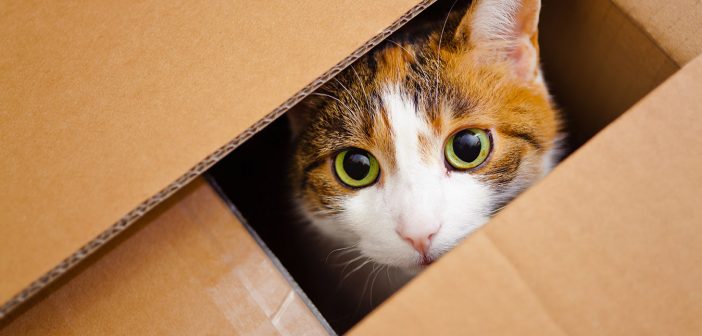by Mona Mistric
Those empty Amazon boxes may be trash to you, but your cat loves them – any box – big boxes, small boxes, odd shaped boxes. All the toys in the world can’t compare to a simple, plain, old, cardboard box.
Why do boxes send our feline friends into a frenzy? Scientists haven’t fully cracked this mystery, but they do have a number of theories. They believe boxes aren’t just fun and games. Your cat may not just like boxes, she may need them. A box can have a positive impact on both her mental behavior and her physiological metabolism. Seeking out confined spaces is an instinctual behavior for cats. In the wild, they hide from predators, covertly stalk their prey and retreat back to their safe place.
Those cardboard walls offer your cat safety and security. According to veterinarian Claudia Vinke of Utrecht University in the Netherlands, the first reaction to a stressful situation of most cats is to withdraw and hide. This is a behavioral strategy of the species to cope with environmental changes and stressors. If she feels overwhelmed or scared, she can retreat inside a box. She feels safe in there because nothing can sneak up from behind or from the side. Anything approaching her will come directly into her field of vision. Vinke also studied stress levels in shelter cats and discovered the cats who had boxes adjusted to their new surroundings faster than those who didn’t. They were far less stressed early on, and were more interested in interacting with humans. The boxes acted as a coping mechanism.
A box creates the perfect environment where your cat can stalk while being shielded from view. She will hide and observe, waiting for the right moment to leap out and surprise her prey. Cats have a strong, flexible body, quick reflexes, sharp retractable claws, and teeth adapted to killing small prey. Without the need to hunt for survival, she still likes to play fearsome, ferocious feline and pounce on your feet or other family members’ – the ultimate sneak attack.
A box can mean it’s time to play, as she waits for toys to be randomly thrown into the box. Or if something interesting passes in front of her, like a toy, she can dash out, get it, and then quickly return to her safe spot.
Corrugated cardboard boxes are a great insulator, keeping your cat warm. The thermoneutral zone for a domestic cat is 86° to 97° Fahrenheit. Humans keep their thermostats around 72°, which is at least 14° colder than cats prefer. Boxes provide comfortable confined spaces where cats don’t have to generate extra heat to keep warm.
Boxes provide cats with a cozy, safe place to sleep, which is very important since they sleep as much as 20 hours a day. So seeking out a good, comfortable, hidden place will allow your cat to get the ample rest she needs.
Chewing the edges of the cardboard is another reason your cat might love boxes. To you it looks like she is just making a mess. To her, she is fulfilling her predatory instinct to hunt, kill, tear and rip off parts of her prey before eating it. She will whittle down and tear up the cardboard mimicking this behavior.
Cardboard boxes are very satisfying objects to scratch. It helps your cat stretch her toes, paws, legs, and shoulders. Scratching allows her to shed the dead outer hull of her nails, revealing the new sharper nail underneath. Scratching is also used to mark territory – both a visual mark and a scent – as cats have scent glands in their paws.
Each box offers a myriad of opportunities for your cat to fulfill her natural instinctual self. Boxes are stress-relieving, comfortable, insulated places where your cat can hide, relax, sleep, and launch a sneak attack against a toy or family member. Climbing, jumping and hiding in boxes is simply part of a cat’s natural behavior, so providing an empty box or two is an inexpensive way to enrich her life.




